Northern Coal Region
Northern Coal region is among the most Lithuanian areas of the USA. Pittston and Wilkes-Barre are the largest cities of such size to have some 4% of the population with Lithuanian ancestry.
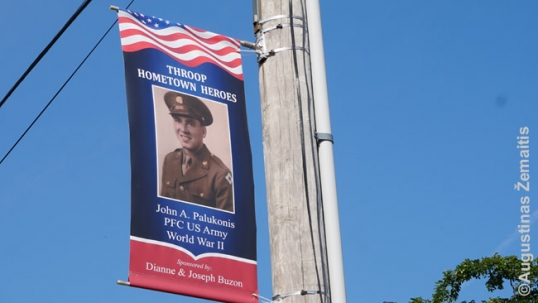
The historic number of Lithuanians in the area is still visible on the veteran memorials, where many Lithuanain surnames are visible. Surnames ending with 'as', 'is' or 'us' are nearly always Lithuanian, while 'cz', 'ch' endings may be Lithuanian surnames as well, although Polonized
Sadly, the Northern Coal Region is also among the places where Lithuanian sites have been hit the hardest in the recent times, many of them destroyed, including the prettiest and largest Lithuanian churches that were also arguably the key Lithuanian sites in the area. Out of 13 Lithuanian Roman Catholic churches in the area, none remain open as standard Catholic churches and nearly all were closed ~2009, despite the fact that mere probability would have required some half of them to stay open (as half of the parishes were closed in the area). 15 Lithuanian churches that used to operate here, by the way, meant that the area had more Lithuanian operating churches than any city in Lithuania until ~1990.
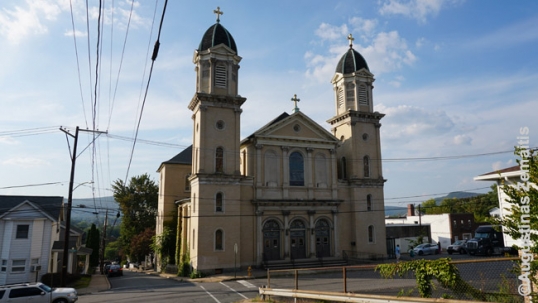
Pittston St. Casimir Lithuanian church, now abandoned
Despite all the destruction, there is still what to see in the Northern Coal Region, ranging from a Lithuanian church independent from Rome, to many cemeteries with century-old graves and Old Lithuanian inscription, to four surviving Lithuanian clubs, to several Lithuanian monuments, to the possibility to descend into a real mine where Lithuanians once toiled, having universally come to this region for coal mining. There is even a Lithuanian-named lake.

Driving down the mine train into the Lackawanna mine
Northern Coal Region is effectively a string of cities between which there is almost no empty space left. At the north, there is Scranton, at the center - Pittston, at the south - Wilkes-Barre. Around this conurbation, there are also numerous smaller towns which are also full of historically Lithuanian sites.
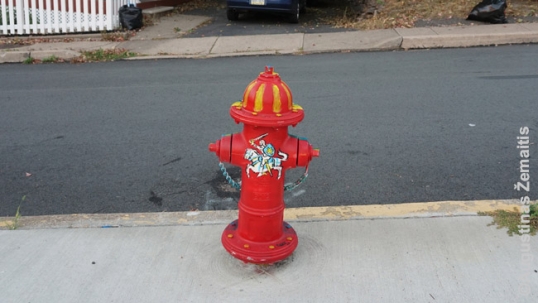
A fire-hydrant colored in Lithuanian colors near the Pittston Lithuanian club
To make the matters simpler, we describe the Lithuanian sites in the area going from north to south.
Forest City Lithuanian sites
Forest City St. Anthony Lithuanian church site
Forest City never had more than 6000 inhabitants (let alone Catholics), yet it had five Catholic churches! That’s because every immigrant nation used to build its own: Lithuanians, Poles, Slovaks, Slovenes, Irish… All of them collected donations from their meager wages. However, more than 100 years on, this lot is all that remains of the white gothic revival Lithuanian church (after the diocese has decided to raze it).
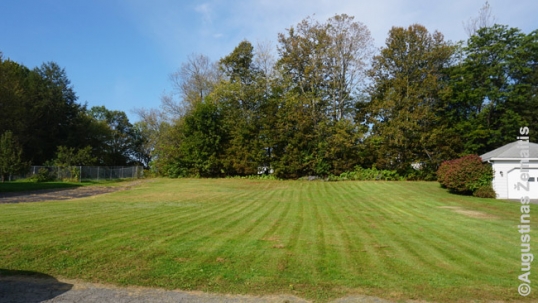
The site of the Forest City Lithuanian church

Forest City St. Anthony Lithuanian church before its demolition (source: brigs.us , Eileen Backofen)
St. Anthony Lithuanian cemetery in Forest City
In the small towns like Forest City, Lithuanians were important. That's because they moved in at about the same time as everybody else and couldn't have been looked down by the earlier arrivals: the town was founded in 1888. Lithuanians also founded their own cemetery, even though the town has merely a few thousand inhabitants and it would seem one cemetery is enough. Such were the times: even having emigrated, the people of each nation sought to be laid to rest among their co-nationals.
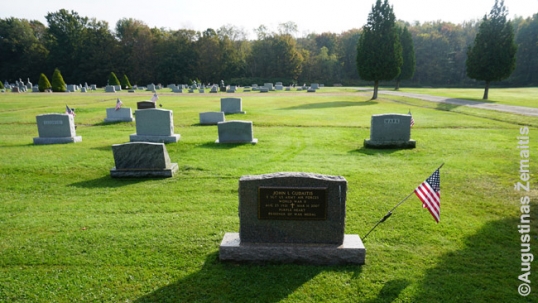
Forest City Lithuanian cemetery
Eynon Lithuanian sites
Eynon Our Lady of Vilna church
Since the 2001 this 1914 building stood abandoned. The only remaining sign of its Lithuanian past was an empty niche for a sculpture of the saint. It bore an English inscription that it was built in memory of the pastor Savulis (a Lithuanian surname). In 2024, the church was completely demolished.

Eynon Our Lady of Vilnius Lithuanian church
Eynon Our Lady of Vilna cemetery
This cemetery shares a commonly fenced ground with the Our Lady of Częstochowa Polish cemetery and there are more Polish than Lithuanian graves. Lithuanians were mostly buried closer to their Our Lady of Vilna church. In the early 20th century, a Polish-Lithuanian conflict raged over the cemetery where blood was spilled.

A Lithuanian grave in Eynon
Downtown Scranton Lithuanian sites
All of the following are so close to each other that it is possible to walk from one of them to another.
Scranton Providence of God Lithuanian National Catholic church
It seems hard to believe, but in 1914 Lithuanians in Scranton did something unprecedented. They established a national Lithuanian Catholic church that was independent of the Pope and which still exists.
At the beginning of the last century, after the Lithuanians of Scranton raised funds and built St. Joseph's Lithuanian Roman Catholic Church, they refused to transfer ownership of the property to the diocese, fearing it would fall into Polish hands, among other things. They litigated in the courts, but, having run out of money, they ceased their legal action and the bishop closed St. Joseph‘s church. Some parishioners decided to split off and establish their own church, completely separate from the Roman Catholic Church and with a priest of their choice. Currently known as Providence of God National Catholic Church, it was constructed from 1915 to 1930 and has operated continuously since then. It now holds Mass every Sunday morning.
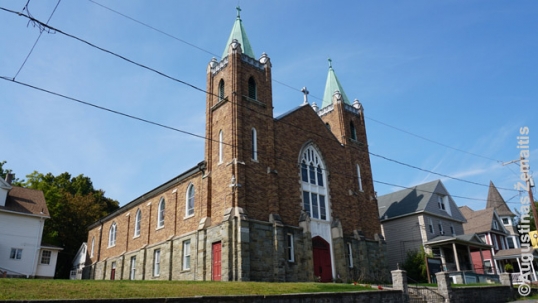
Lithuanian National Catholic Church in Scranton
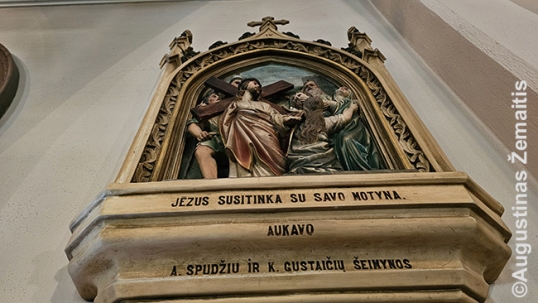
Station of the Cross

Detail of a stained glass window
This is the only church in the entire region that remains officially Lithuanian. This fact attracted new parishioners in 2009 when some Roman Catholic Lithuanian parishes were closed.

Scranton Providence of God Lithuanian Catholic Church cornerstone with Lithuanian inscription
The church raises funds from the annual picnics it organizes each summer.
Tauras Lithuanian Club in Scranton
One of four Lithuanian clubs in the Scranton region! At the entrance, a Lithuanian flag is waving. Inside, the most Lithuanian-decorated part is the hall and entrance, which has descriptions of Lithuania and images of the Lithuanians who created the club. Currently, the club has 1300 members (2023) and is the largest Lithuanian club in the area, although not only Lithuanians can be members now. In addition to the bar hall, there is another hall behind where events take place.

Tauras Lithuanian club in Scranton

Carpet at the Tauras club entrance showing Tauras. Tauras in Lithuanian means Aurochs, a now-extinct animal from the region.

A clipping at Tauras club entrance describing Lithuania
Kosciuska Healing Garden
“Lithuanian sites are so rapidly disappearing, therefore, I wanted to create a new one” – said the creator of the Kosciuska garden Carol Gargan (of Lithuanian origins). She is planting the garden with her own hands and named it after Tadas Kosciuška – this is the Lithuanian variant of the name of Polish-Lithuanian leader more commonly known in Polish as Kosciuszko, also a US hero. In 2018, additional plaque was installed to commemorate the 100th years anniversary of the foundation of the Republic of Lithuania. It includes quotations from Kosciusko and historical facts about Lithuania and Lithuanians.

Kosciuska healing garden sign
Scranton St. Joseph Lithuanian church
The 1895-build church is still open, however, it now belongs to ex-Anglican priests. Nevertheless, the Lithuanian stained glass windows, the chapel-post for the Soviet-persecuted Lithuanians all survive. So does the cornerstone inscription “Lithuanica Ecclesia”.
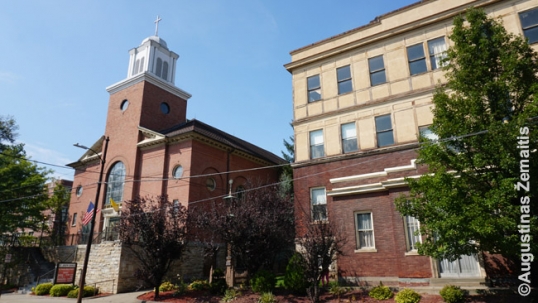
Scranton St. Joseph Lithuanian church
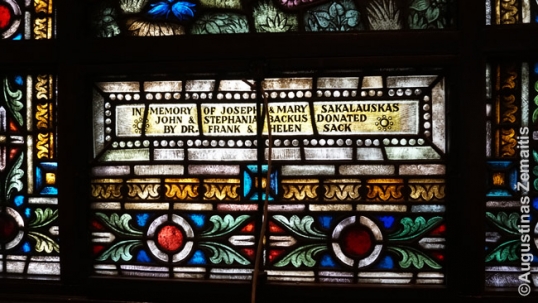
Scranton St. Joseph Lithuanian church stained-glass window with a donor's Lithuanian surname
St. Joseph Lithuanian school in Scranton
So many Lithuanian children must have gone to school in Scranton at 1915 when the construction here began! The school has been closed for a long time but the cornerstone still boasts a Lithuanian-language inscription that means “St. Joseph school 1915”. ~2018, the school was reopened as an academy for helping homeschooled children with some additional lessons. While not catering solely to Lithuanian children, this new academy is named Marija Kaupas Academy, after the Blessed Marija Kaupas (Kaupaitė), a Lithuanian who founded a Lithuanian nun order in Scranton. This order of St. Casimir Sisters later spread across America, making Marija Kaupas venerated both among the Lithuanian-Americans and Scranton Catholics.

St. Joseph Lithuanian school
Lithuanian chapel-post for Soviet-oppressed Lithuanians
This chapel-post, according to the inscription, is dedicated to the men of women who fell for “our country” (Lithuania), and also Lithuanians who suffer beyond the Iron Curtain, and the dead parish members. Such were the main concerns of the Lithuanian-Americans in 1975 when the chapel-post was erected, even though ~70 years had passed already since most of them moved to Scranton! On top of the chapel post there is an image of Rūpintojėlis, a Lithuanian-folk-traditional image of a worried Jesus.
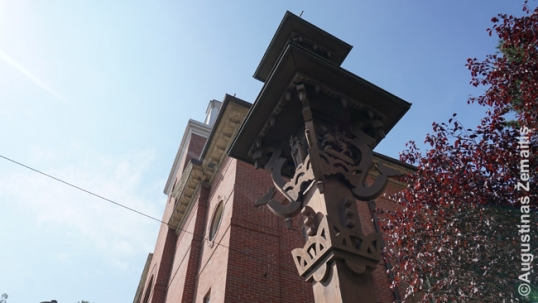
Scranton chapel-post with Rūpintojėlis visible (left)
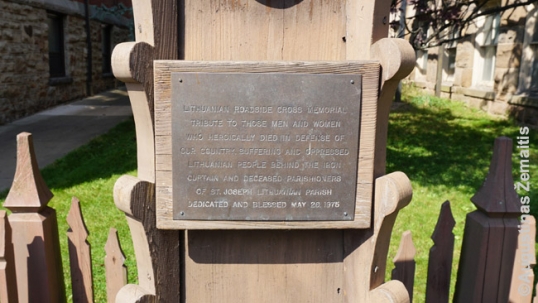
Scranton Lithuanian chapel-post explanation
Scranton area Lithuanian sites further away from the downtown
The following sites will require a drive from the downtown Scranton.
Lithuanian National Cemetery in Scranton
This is a Catholic cemetery but not Roman Catholic. National Catholics who are not following the Pope are buried here (see the "National Catholic church" section above). The first bishop of this unique church Jonas Gritėnas also lies in this cemetery. He sought to export his ideas back into Lithuania, however, fell ill and died, leaving the Lithuanian National Catholic Church solely a Lithuanian-American phenomenon.

Lithuanian National Catholic Cemetery
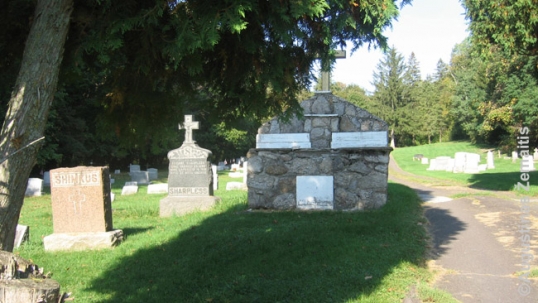
Lithuanian National cemetery near Scranton
Bishop Jonas Gritėnas grave in the Lithuanian National Cemetery near Scranton
Jonas Gritėnas (1884-1928) was the first bishop of the unique Lithuanian National Catholic Church that declared its independence from the Pope. It held Mass in the Lithuanian language even when Roman Catholics still used Latin. A long Lithuanian epitaph says Gritėnas sought spiritual freedom for his people, while the emblem of the church reads „Fight. Light. Truth“.
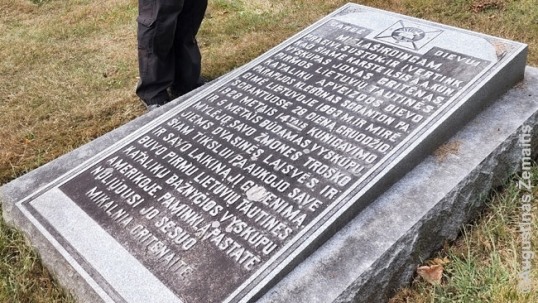
Bishop Gritėnas grave
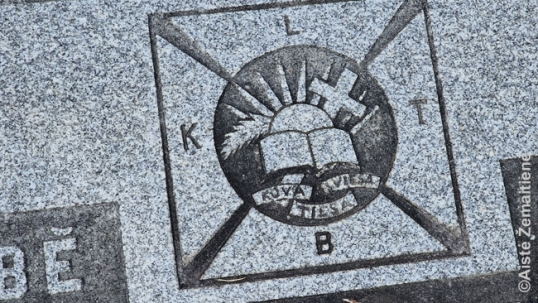
Emblem of his church on the Gritėnas's grave
St. Joseph Lithuanian cemetery in Scranton
A massive Lithuanian cemetery! It has a pretty cemetery cross. There are very old graves.

St. Joseph Lithuanian cemetery in Scranton

St. Joseph Lithuanian cemetery in Scranton
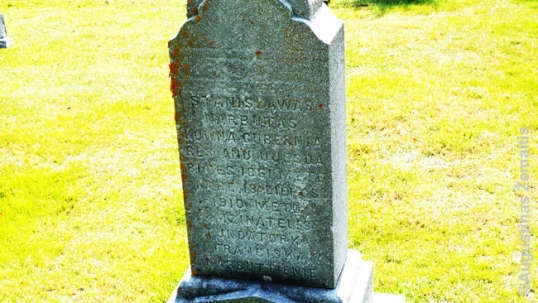
A grave in Scranton with an old Lithuanian epitaph
Lackawanna Coal mine and museum in Scranton
Here you may descend into a real coal mine, once staffed by Lithuanians! Of course, everything is easier for the tourists: the floor is not covered by underground water, there is no more risk to enter flammable or poisonous gases… The death rates used to be huge here, and the dead miners used to be placed on their wives’ front porches! This and even scarier stories of 19th-century immigrant laborer lives may be listened here.
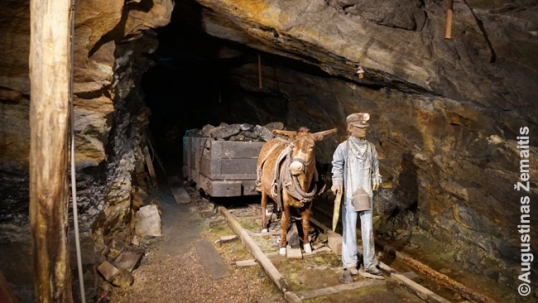
Lackawanna mine in Scranton
Scranton St. Michael Lithuanian church
Currently, this church belongs to the traditionalist Catholics who hold there the Latin Tridentine mass. Stained-glass windows with Lithuanian inscriptions survive on the inside. The current brick church was built in 1942. The Lithuanian language declined here earlier than in the neighboring St. Joseph parish, with few parishioners still speaking Lithuanian by 1970s.
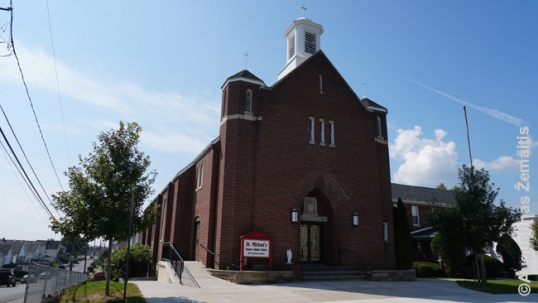
St. Michael Lithuanian church in Scranton
Elmhurst St. Mary Villa Lithuanian sites
St. Mary villa is a complex of a Lithuanian monastery (now an assisted living institution) and a Lithuanian cemetery east of Scranton.
St. Mary villa in Elmhurst
Mining jobs most Lithuanian men had were especially dangerous. Some would be killed by explosions, others by poisonous gas… To accommodate the surviving widows and orphans, priest Urbanavičius created this home where Lithuanian nuns would care for these unlucky people. Currently, the Lithuanity remains only in the images that cover the walls, the names in donations list, the traditional sun-cross on the roof, the inscription on Mary statue. Now the home cares for senior citizens.

Traditional Lithuanian Sun-Cross on top of the St. Mary Villa. This version of cross, especially popular among the Lithuanian-Americans, combines the Christian (cross) and pre-Christian nature-worshipping (sun) symbolism

Image of the early nuns at what is now St. Mary villa, located in the St. Mary villa
Mary sculpture with Lithuanian inscription
Among the last things on the exterior of St. Mary villa that reminds of Lithuania is this statue. To see its Lithuanian inscription, come closer (in summers, it is often covered by flowers and therefore only the English inscription is visible from further up).
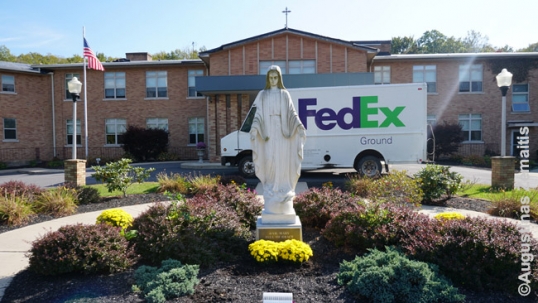
Virgin Mary sculpture in front of the St. Mary villa
Elmhurst Lithuanian cemetery
As this cemetery has been established for the nuns near a monastery (now the St. Mary Villa), most of the graves here are modest, consisting of small plaques now overgrown in grass. Exceptional are the priest graves and a line of the graves of patriotically-minded Lithuanians, adorned by the Columns of Gediminas and other Lithuanian symbols.

St. Mary Villa cemetery
Pittston area Lithuanian sites
These Lithuanian sites are located in Pittston, which is the most-Lithuanian (by percentage) city of such size in the USA, and the surrounding towns. Pittston is effectively in the center of the Scranton/Wilkes-Barre conurbation.
Pittston St. Casimir Lithuanian church
Just one look at this church is needed to be overwhelmed by its size and grandeur! For 99 years (1909-2008) this was the hub of Pittston Lithuanians, yet nothing reminds that: even the cornerstone was removed. The new owner planned to showcase art here but, after the former church being vandalised, she sold it again, continuing its abandonment. Currently, the church is used as a residential building, however, the authentic interior still remains.
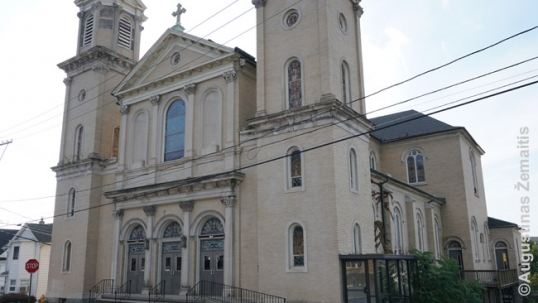
St. Casimir Lithuanian church of Pittston

The removed cornerstone of Pittston St. Casimir Lithuanian church
Lithuanian Social and Benefit Club in Pittston
Approaching this club, your eye will be drawn to a hydrant painted in the colors of the Lithuanian flag and coat of arms! This club is arguably the most Lithuanian among those left in the region. The club has a Lithuanian-themed bar (members-and-friends only). The club has ~45 full members as of 2023 with several hundred social members.

Pittston Lithuanian club
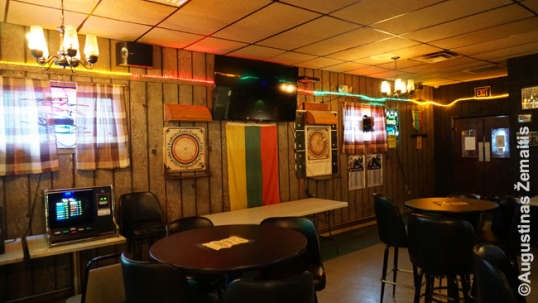
Pittston Lithuanian club interior
St. Casimir statue in Pittston
This statue is all that remains in religious use out of the massive St. Casimir Lithuanian church after its closure. When closing churches, the bishops often try to pacify the disgruntled parishioners by offering them to keep some dearest parts of the former church (and move those parts into a new church). As this Irish church had many other parishes consolidated it, its entry hall now reminds a sculpture gallery with St. Casimir not easily distinguishable.

St. Casimir statue in Pittston, relocated from the Pittston Lithuanian church
St. Casimir Lithuanian Cemetery in Pittston
One of the largest of the northern Coal region Lithuanian cemeteries belonged to the massive St. Casimir church of Pittston.

Pittston St. Casimir Lithuanian cemetery entrance

St. Casimir Lithuanian cemetery in Pittston gravestone
Duryea St. Joseph Lithuanian church site
Yet another Lithuanian church in the Pennsylvania Coal Region that was recently torn down by the diocese’s bulldozers, disregarding the opinion of the parish members. This small wooden church was demolished in 2013.
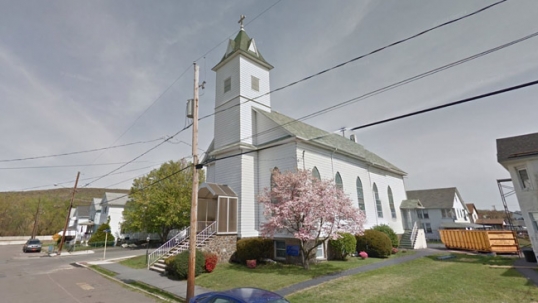
Now-demolished Lithuanian church of Duryea. Google Street View image
Exeter Lithuanian club
One of four Lithuanian clubs in the Northern Coal region! The exterior is painted in Lithuanian tricolor. Only the members and those with members may enter inside.
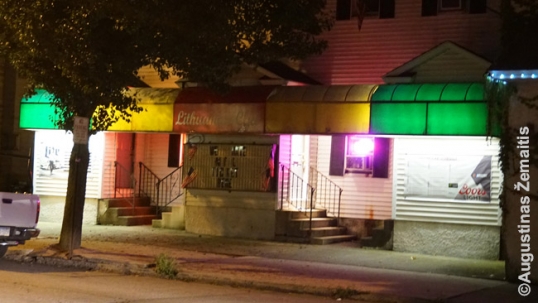
Exeter Lithuanian club
Inkerman Lithuanian citizens club
This Lithuanian club used to be nicknamed the “Bucket of blood” – so common were the fights here. It was built by interwar Lithuanian miners by their own hands, although today not only Lithuanians frequent it. Lithuania-related inscriptions still remain.
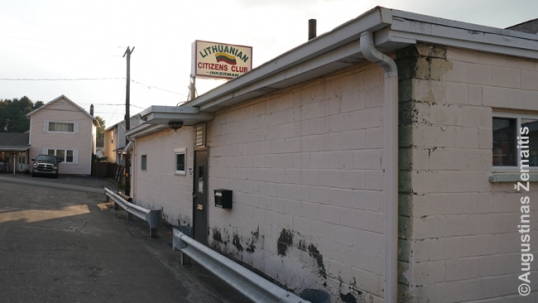
Inkerman Lithuanian club
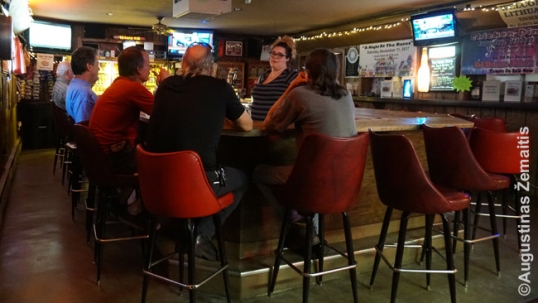
Inside the Inkerman Lithuanian club
Kingston area Lithuanian sites
These Lithuanian sites are located on the opposite bank of the Susquehanna River from Wilkes-Barre.
Kingston St. Mary Annunciation Lithuanian church site
After closing this grand Lithuanian church, the diocese was unable to sell it. Therefore, they have demolished it in 2016. When looking at the empty lot where a magnificent church once stood, take a time to think how quickly the Lithuanian-American heritage disappears.
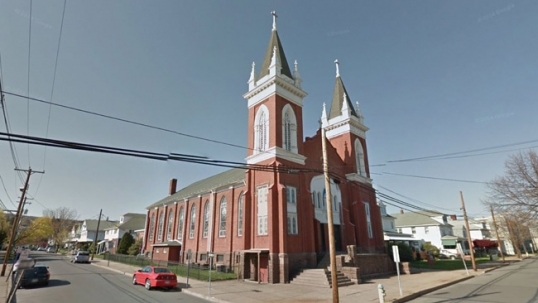
Now-demolished Kingston Lithuanian church of St. Mary Annunciation. Google Street View image
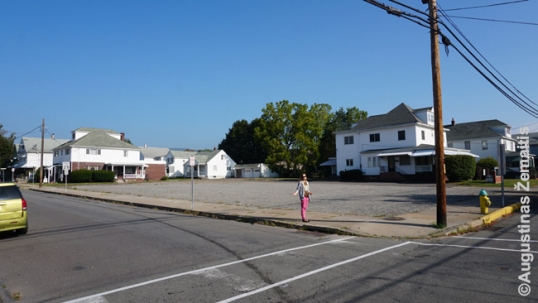
The site of the destroyed Lithuanian church
St. Mary Annunciation Lithuanian cemetery in Kingston
The dead of the Annunciation parish used to be laid here. The name “Lithuanian” still remains at the entrance and there are many Lithuanian graves. The parish church was demolished in 2016, so this is all that remains of that parish.

St. Mary Lithuanian Cemetery
Luzerne St. Ann Lithuanian church
The church construction began in 1924 but it was then halted by the Great Depression. For long, Lithuanians prated in the basement and only in 1959 did they complete the church. Maybe this newness made the diocese to chose this building as the one that should remain after the consolidation of the area's parishes. While no Lithuanian signs remain on the exterior, the stained-glass windows inside are adorned by Lithuanian names (given that the church was built in the 1950s when the American-born generation of Lithuanians were already in the majority, the inscriptions are, however, in English).
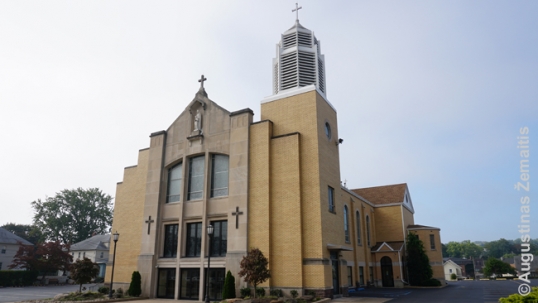
St. Anne Lithuanian church in Luzerne
Lithuanian independent cemetery
Cemeteries, cemeteries, cemeteries! So many of them have Lithuanians established in the region. Most were parish-affiliated whereas the “Independent” ones were typically created by the less religious: leftists and nationalists. As the cemetery has interments from a wide area of the region, is partitioned into lots according to the cities/towns where those Lithuanians lived; these lots are marked by signs.

Independent Lithuanian cemetery of the West Wyoming
Old St. Mary cemetery in Larksville
The site of the most infamous Lithuanian-Polish conflict in America! The parish used to be binational, yet the Poles sought it to be Polish-only. So, they used to stop Lithuanian funerals coming to the cemetery and, in the most notorious episode, dug out the graves of Lithuanian children and mutilated the corpses with axes. Lithuanians then established the Old St. Casimir cemetery nearby.
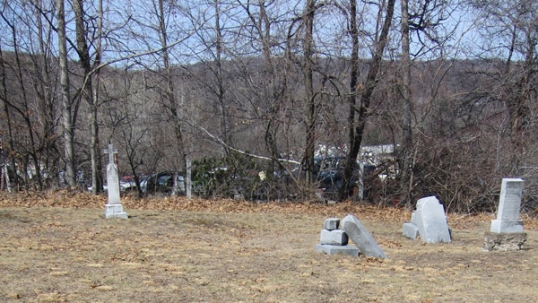
St Mary Polish cemetery in Larksville
Old St. Casimir Lithuanian cemetery in Larksville
Lithuanians were forced to establish their own cemetery in Larksville as in the joint Polish-Lithuanian cemetery, the Poles were attacking their processions and even dug out dead Lithuanian children, mutilating their bodies with axes. The cemetery is in a good condition in a forest; famous priest Burba is buried here under a massive gravestone. The local urban legend claims that the forest location for the cemetery was chosen to "hide it from the Poles". Later the parish outgrew this cemetery and acquired a new cemetery in Hunlock.
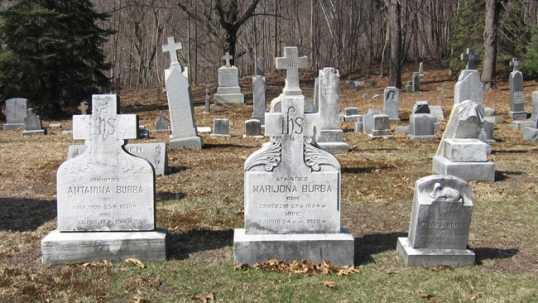
Larksville St. Casimir cemetery
Priest Aleksandras Burba grave in the St. Casimir Lithuanian Cemetery of Larskville
Priest Burba (1856-1898) is considered the first Lithuanian-American priest to have attempted creating a Lithuanian parish. His massive gravestone (the largest in the cemetery) expresses the gratitude of Lithuanians, with the Lithuanian epitaph reading „To the worthy co-national. Lithuanians“.
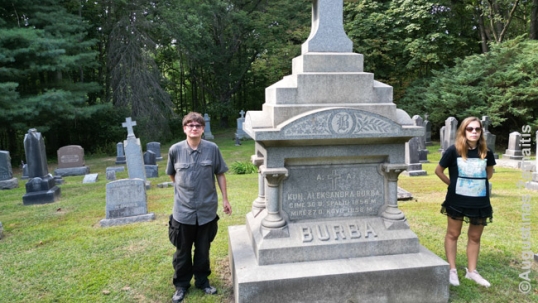
Priest Burba grave
Wilkes-Barre area Lithuanian sites
These sites are located in Wilkes-Barre, the area's second-most-Lithuanian significant town, and its suburbs.
Wilkes-Barre Holy Trinity Lithuanian church site
The great gothic revival Holy Trinity church, built by Lithuanian hard-earned money, was destroyed not in some kind of historic calamity but rather by the diocese decision (disregarding the Lithuanian protests) in 2015. Unfortunately, such was the fate of many Lithuanian-American churches. In the empty lot now a small lonely cross stands, likely erected by Lithuanians.

Now-demolished Holy Trinity Lithuanian church of Wilkes-Barre. Google Street View image.

The now-empty site of the Holy Trinity Lithuanian church of Wilkes-Barre

A cross that stands on the location of the Holy Trinity Lithuanian church
Holy Trinity Lithuanian cemetery in Wilkes-Barre
This is a grand and pretty cemetery with memorials that have Lithuanian inscriptions: a memorial for the Lithuanians who died in the World Wars and a cemetery cross with a Lithuanian prayer inscribed on it. Starting in 1935, the cemetery accepted the parishioners of the massive Holy Trinity church which was destroyed in 2015.

Wilkes-Barre Holy Trinity Lithuanian Cemetery entrance
Holy Trinity cemetery cross in Wilkes Barre
The cross on the mound has a Lithuanian inscription: “Jei draug su Kristumi mirėme, draug su Kristumi ir gyvensime” (“If we’ve died with Christ, we’ll live with Christ”).
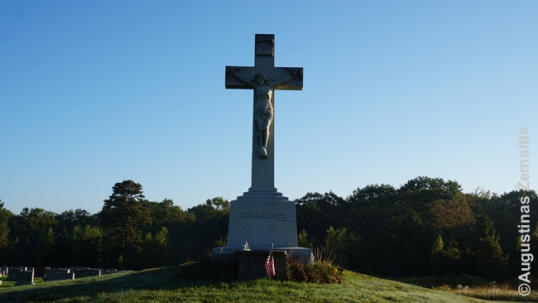
Wilkes-Barre Lithuanian cemetery cross
Memorial for the Lithuanians who died in the World Wars
You’d rarely see non-English inscriptions on the WW2 memorials for those who died serving the US army. The one in the Holy Trinity cemetery is an exception. In Lithuanian, it asks for an eternal peace to those Lithuanians soldiers. Interestingly, some of these soldiers have emigrated from a Russian-occupied Lithuania to avoid service in the foreign Russian army only to eventually died in a war for the USA.
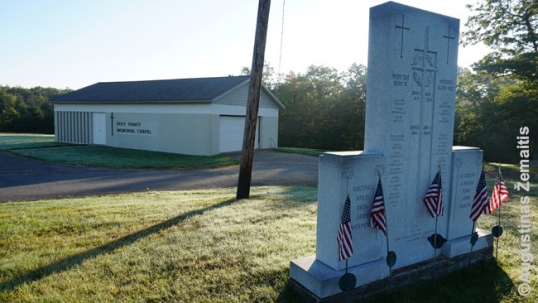
Wilkes-Barre Lithuanian cemetery World War 2 memorial
Old Holy Trinity Lithuanian cemetery in Wilkes-Barre
Before the Holy Trinity Lithuanian parish grew so large it needed the massive new cemetery on the outskirts of the city, its members used to be buried at this old cemetery in the Kidder St. of Wilkes-Barre Township. In the cemetery amidst the old graves the cornerstone of the now-demolished Holy Trinity church of Wilkes-Barre is laid.
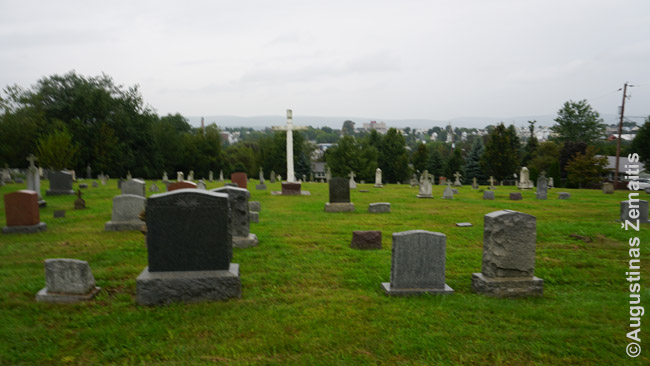
Old Holy Trinity Lithuanian Cemetery of Wilkes-Barre
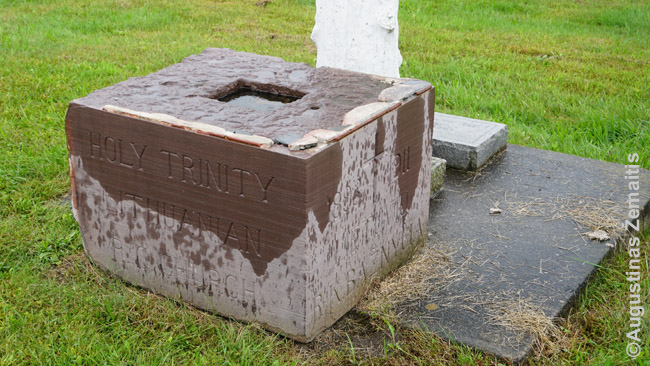
Holy Trinity Lithuanian church cornerstone in the Old Holy Trinity Lithuanian Cemetery
Wilkes-Barre St. Francis Lithuanian church
Nothing here reminds the Lithuanians who built the church ~1918 and operated it for 90 years. Even the cornerstone with the construction year and original purpose inscribed has been removed! Currently, it is a Hispanic Seventh-Day Adventist parish.
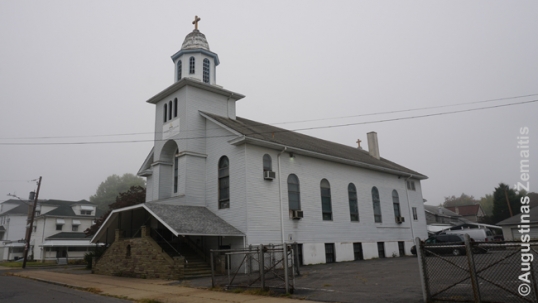
Miners Mills Lithuanian chruch
St. Francis Lithuanian cemetery in Wilkes-Barre
A small cemetery on the hillside that belonged to the St. Casimir Lithuanian parish.

St. Francis cemetery in Wilkes-Barre
Wilks-Barre All Saints Lithuanian National Catholic church
Here the Lithuanian Catholics of Wilkes-Barre who denounced the Papal reign would have prayed. They used Lithuanian language even when Roman Catholics still had their Masses in Latin. The church is closed but the cornerstone still has Lithuanian and English inscriptions „Lith. Nat. Cath. Church of All Saints 1932“.
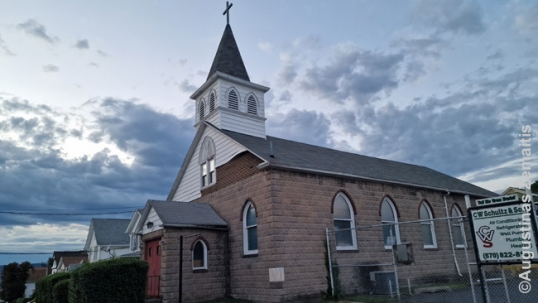
Wilkes-Barre Lithuanian National Catholic church
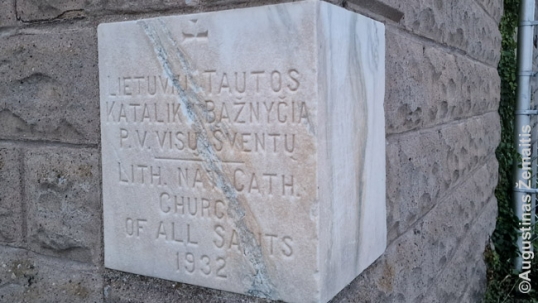
Wilkes-Barre Lithuanian National Catholic church inscription
Wilkes-Barre St. Casimir Lithuanian church
The Old St. Casimir church effectively caved into the mines. Such “exotic” fate was common in the Coal Region, where mining activities went on under nearly every home. Back then, in the 1950s, the culture of legal compensations was not as prominent and Lithuanians had to build this new church on their own in 1957. It still stands, yet it has nothing Lithuanian now.
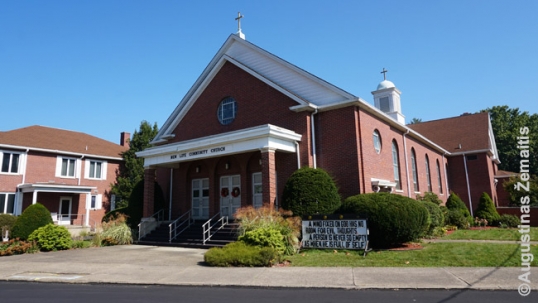
Wilkes-Barre St. Casimir Lithuanian church
Lithuanian sites in the Northern Coal Region's west
These Lithuanian sites are located out of the main conurbation, in the small mining towns west of Wilkes-Barre.
Sugar Notch St. Peter and Paul Lithuanian church
In 1913, the building was acquired from Presbyterians. Those were the times before the advent of automobiles, so, once they would amass some money, Lithuanians sought to build their own church so they wouldn’t to have to spend much of the Sundays (the sole non-working day) commuting to the Plymouth Lithuanian church (St. Francis), or go to the Polish church which reminded them of a high treason. This parish never had more than ~300 Lithuanians.

Sugar Notch Lithuanian church
Ss. Peter and Paul Lithuanian Cemetery in Sugar Notch
A small Lithuanian cemetery of a small coal town. On the gravestones, you may see anglicized pre-war Lithuanian words such as “Nuzudytas mainose” (“Killed in the mines”; non-Anglicized Lithuanian would be “Žuvo kasyklose”).
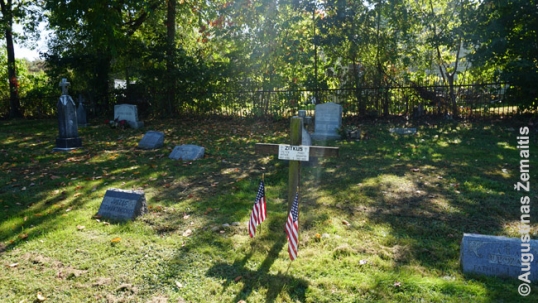
Sugar Notch Lithuanian cemetery
Nanticoke St. Joseph Lithuanian church
This large wooden church never was a separate Lithuanian parish: it was served by the Lithuanian priest from Wanamie. After its closure, in 2004, it was bought by a local architect Norieka who transformed it into a single-family home. Stained-glass-windows and decor and even some furniture remains. All the Lithuanian inscriptions also survive, as does the Lithuanian priest memorial in the churchyeard, making this one arguably the most authentic Lithuanian church building among those that were converted to other use. The tower is now a room with views.
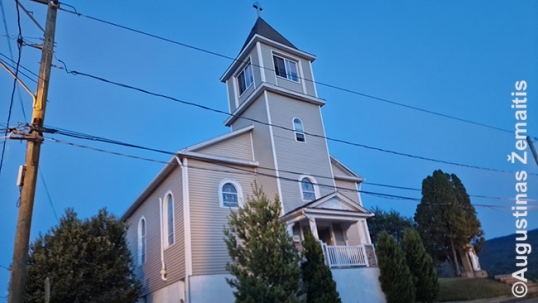
Nanticoke St. Joseph Lithuanian church

Lithuanian stained-glass window in the interior
Lithuanian priest memorial in Nanticoke
Usually when a Lithuanian church is closed in the USA, all the religious symbols and monuments are removed. However, in Nanticoke, the new owners who live in the church nearby have saved this memorial for a Lithuanian priest.

Lietuvio kunigo paminklas prie Nantikoko bažnyčios
Lithuanian cemetery in Nanticoke
This unmarked cemetery is a burial place for the Lithuanians of Nanticoke. The graves closer to the road are in rather good condition but those towards the forest are largely overgrown. Numerous graves are with old Lithuanian inscriptions.
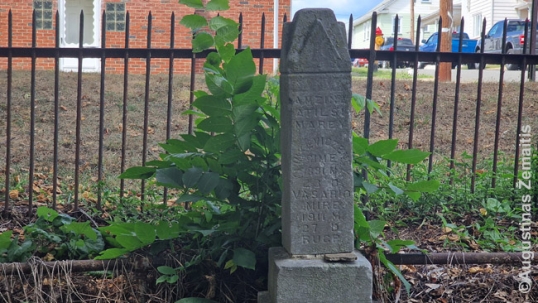
Lithuanian cemetery in Nanticoke
Wanamie St. Mary Lithuanian church
Just as in many small towns of Coal region, the closed Lithuanian church is no longer in use and stands abandoned. Construction started on 1925.

Wanamie Lithuanian church
St. Mary Lithuanian cemetery in Wanamie
A small cemetery of a small parish. Judging by the surnames on gravestones, non-Lithuanians also used to be buried here. That’s because this is the parish’s new cemetery, from the times Lithuanian language was already disappearing – the old cemetery with historic inscriptions is described below.
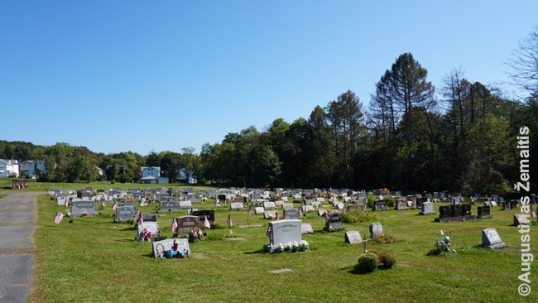
Wanamie Lithuanian cemetery
Old St. Mary Lithuanian Cemetery in Wanamie
A romantic cemetery amidst forest, accessible solely by a dirt road. Many of the graves are very old (from the 1900s-1920s) as the parish later acquired a new cemetery. Many graves have lengthy inscriptions in pre-modern Lithuanian language.
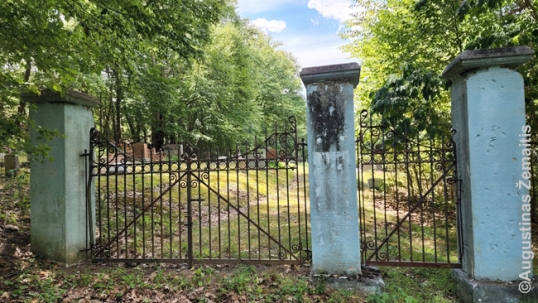
Old St. Mary Lithuanian Cemetery of Wanamie

Old St. Mary Lithuanian Cemetery of Wanamie
New St. Casimir Lithuanian Cemetery in Hunlock
The new cemetery of the St. Francis Lithuanian parish has been established quite far from the church, as the automobile era was approaching (1925). The cemetery entrance has a Lithuanian inscription and there is also a cemetery memorial near the center with Matt Gospel quotations in Lithuanian. The old cemetery is in Larksville (see above).

Hunlock cemetery with the cemetery memorial on the right
Lithuanian sites further away
Lake Kasulaitis
This small lake is likely the only one Lithuanian-named lake in the USA, and possibly the Lithuanian-named lake that is the furthest from Lithuania! Joseph (Juozapas) Kasulaitis, by the way, was not some kind of a celebrity – rather, he was a farmer who spent decades farming in the region. The lake was formed/expanded with a construction of a dam in 1955. Sadly, the dam has been lost to the flood of 2005, diminishing the lake to a rather small widening of the river.
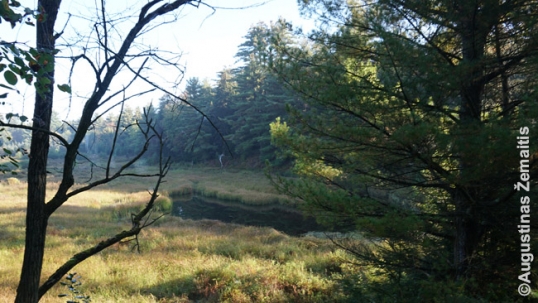
Lake Kasulaitis in the Northern Coal Region

Lake Kasulaitis in its prime size, 1969. Photo courtesy of Mark Kasulaitis, the granson of the dam's builder
The map
All the Lithuanian locations, described in this article, are marked on this interactive map, made by the "Destination - America" expedition (click the link):
Interactive map of Pennsylvania northern Coal Region Lithuanian sites
Share this:
Article by Augustinas Žemaitis
Language
True Lithuania services
Sister websites
True Lithuania – Extensive website on Lithuania, its culture, cities, history and more
Our Youtube – English videos on Lithuania and interviews with Lithuanians abroad
Destination Lithuanian America – Map of 800+ Lithuanian heritage sites in the USA and Canada
Comments
- Lisa Lapin on New Hampshire
- Reece Lyons on
- Bob Reich on Pittsburgh, Pennsylvania
- Telkom University on Philippines
- Telkom University on Vancouver, British Columbia
Donations
Advertisement
Youtube
Info
- Destination Lithuanian America
- Differences between Lithuanians and neighboring nations
- Divine Mercy: Lithuanian-originated Christian tradition
- Foreign locations named after Lithuania
- Grand Duchy of Lithuania castles abroad
- How to save Lithuanian-American heritage
- Lithuanian camps
- Lithuanian cemeteries abroad
- Lithuanian Churches Abroad
- Lithuanian Convents abroad
- Lithuanian diaspora cuisine
- Lithuanian districts abroad
- Lithuanian Halls abroad
- Lithuanian heritage abroad: what is it?
- Lithuanian minority heritage abroad
- Lithuanian museums abroad
- Lithuanian Schools abroad
- Maps of Lithuanian heritage abroad
- Similarities between Lithuanians and other nations
- Website author Augustinas Žemaitis
- Top Lithuanian locations outside Lithuania
- Lithuanian streets and monuments outside Lithuania
Topics
Andrew / Kunta Kinte island Bar Do Vito Sao Paulo Gardinas Palaces Golshiany Palace Grodno Palaces Kengyr Gulag uprising monument Kosava Palace Krėva / Krevo Palace Lida (Lyda) Castle Lida Palace Lithuanian chapel of Washington National Shrine Lithuanian colonies in Africa Lithuanian colony in Gambia Lithuanian consulate general in Latin America Lithuanian district of Sao Paulo Lithuanian embassy in the USA Lithuanian embassy to the European Union Lithuanian Martyrs chapel in Rome Lithuanian migration to Brazil Lithuanian migration to Uruguay Lithuanian shopping malls in Georgia Lithuanians in Bayonne (New Jersey) Lithuanians in Brazil Lithuanians in Jersey City Lithuanians in Kearny (New Jersey) Lithuanians in St. Lawrence (Verano) cemetary Lithuanian Uruguayan cultural society Lituanica (Lithuania) square in New York City Minnesota Lithuanian community Mir (Myras) Castle Navahrudak (Naugardukas) Castle Nesvizh (Nesvyžius) Palace New Jersey St. Paul and St. Peter Lithuanian church Our Lady of Vilnius chapel in Rome Peshchenlag Lithuanian prisoners monument Ruzhany (Ružanai) Palace St. Michael Lithuanian church Bayonne Steplag Lithuanian prisoners monument Transfiguration church in Brooklyn Transfiguration church in Queens Vila Zelina in Sao Paulo Villa Lituania in Rome Vilnius square in Tbilisi (Georgia) Vilnius University model in Mini-Europe park (Brussels) Wilno village in MinnesotaMain sponsors this year:


Department of Cultural Heritage of Lithuania
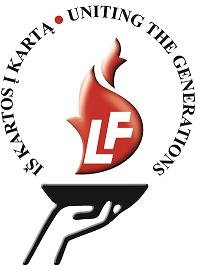

Lithuanian Foundation, Inc.


Press, Radio, and TV Support Fund of Lithuania



December 28th, 2017 - 18:22
Beautiful illustrations
December 28th, 2017 - 19:46
Thank you!
March 28th, 2018 - 14:50
Aciu!!! Malonu jausti zemiecius…
May 25th, 2018 - 03:55
About the Kasulaitis lake picture, that is from after the damn was destroyed in a flood. It is more of a river now. My family probably has pictures of the original lake if you are interested in correcting your information.
May 25th, 2018 - 10:25
I have contacted you by e-mail regarding the images.
July 14th, 2018 - 16:09
I think Lithuanians were quicker than many nationalities to assimilate. My father had 100 percent Lithuanian ancestry and my mother had 100 percent Irish ancestry. That’s America!
November 17th, 2019 - 22:32
Yes, but our father had so many earned advantages through sports and the military by which he escaped the mines and changed the direction of our family. Most young Lithuanian men, born in the northern hard coal regions, were not as fortunate as him. He wanted to be the all-American man he became and of course love played a part!
September 12th, 2018 - 05:03
I have been searching for years for the old st.casimirs church and cemetery, how saddened I am of learning that this once beautiful church is now gone. Generations of my family have gone to sevices, weddings and funerals here. Most of my Visnefski family is buried at the old casimirs church cemetery, now my only hope is that it remains there until I get a chance to visit family up north again soon. I would so love to be able to take some pictures of their headstones. If anyone by chance has any information on Joseph or Anthony (Tony) Visnefski from Annandale hill Plymouth, or Michalena Visnefski (Marchakitus) from the Wilkes-Barre area, her daughter Lorraine Marchakitus (Howey) from E. Stroudsburg, please email me gvisnefski@gmail.com Thank you
February 6th, 2021 - 15:14
This was a wonderful accidental surprise to uncover this site.
April 8th, 2021 - 16:56
Thank you for your deep and broad research. My father was of this region, his parents emigrated to it. Stanley Kulikowski, coal mine laborer; his wife Agatha (Burbulis) sometimes took Sunday morning bus to Forest City for Lithuanian language mass, as my aunt now tells me. But overall, my family’s first generation born here were not focused on their past heritage; mines closing, prosperity ending, Great Depression etc. were more pressing. Your site fills in gaps for me, thanks again.
February 26th, 2022 - 18:16
545 220641Hello! Great stuff, please keep us posted when you post again something like that! 62393
August 9th, 2022 - 19:08
does anyone know the name of the cemetery most used by lithunianins from st josephs church in scranton, noreika funeral home. i moved to california and would like to be buried next to my mother, but do not know the name of the cemetery and catholic diocese is of no help. her name was anna ilgavizius. (mogilewsky)
August 18th, 2022 - 15:10
Hi Barbara, my great grandmother’s brother Joseph Lenkis is buried at Saint Catherine’s Cemetery in Moscow, PA. He lived in Scanton, attended St Joseph’s Lithuania Church and Noreika Funeral Home took care of his funeral. You should contact the cemetery to confirm your arrangements and where your mother is buried. There is another cemetery only feet away called Moscow Cemetery that has no connection to Saint Catherine’s Cemetery. You look it up on Google Maps. Take a look at his Findagrave memorial and find contact info for the cemetery. Good Luck https://www.findagrave.com/memorial/238414175/joseph-lenkis
August 18th, 2022 - 15:26
Barbara, email Dave Smith for burial information.
dsmith@dioceseofscranton.org
August 19th, 2022 - 23:35
It should be St. Joseph Lithuanian cemetery of Scranton, PA.
February 6th, 2023 - 04:51
Cathedral cemetery is a possibility.
August 9th, 2022 - 19:09
st josephs church in scranton
August 10th, 2022 - 19:37
Does anyone know who manages/owns the Lithuanian Independent Cemetery in West Wyoming that is mentioned here?
August 18th, 2022 - 15:22
AP, if you are trying to contact that cemetery try to get that info from a funeral home. When I googled that name, Findagrave is showing there are two cemeteries with that same name in the same county. Good luck